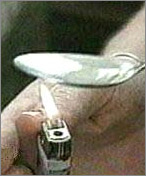The BONDS Treatment protocols
The long running detox program at Cygnet Hospital Harrogate, Detox 5, was based on the BONDS protocol (Beaini Opiate Naltrexone Detoxification System). The BONDS protocols are now the basis of a new treatment service, The New Life Centre, treating:
- Addictions (Any Substance Misuse, Gambling and Sex Addiction)
Telephone: 0800 433 7220
Email: Info@TheNewLifeCentre.com
Here is the abstract of the published research on The BONDS Treatment Protocols. The full paper was published in Addiction Biology October 2000.
A COMPRESSED OPIATE DETOXIFICATION REGIME WITH NALTREXONE MAINTENANCE: TOLERANCE, RISK ASSESSMENT AND ABSTINENCE
BEAINI AY, LANGSTAFF P, CARR MP, CROSSFIELD JN, SWEENEY RC
and Harrogate Detox 5 Centre, Harrogate, UK
JOHNSON TS, Sheffield Kidney Institute, Northern General Hospital, Sheffield, UK
Phone: +44 (0) 114 271 5322
Fax: +44 (0) 114 271 4410
Email: t.johnson@sheffield.ac.uk
Reducing methadone programs have until now provided the major route for opiate detoxification. However these are not only slow and expensive, but the patient generally has a degree of discomfort resulting in a high level of drop out before completion of the detoxification.
The development of rapid and ultra rapid detoxification protocols based upon the administration of an opiate antagonist under heavy sedation or general anaesthetic have revolutionised opiate detoxification providing a mechanism for addicts to become clean in a pain free procedure in 4 to 48 hours.
By necessity these protocols are reliant on high dependency facilities which limits their use and, perhaps unfairly, been associated with a high level of risk such that the UK Advisory Council on the Misuse of Drugs have failed to recommend their use.
Accelerated techniques still using precipitated withdrawal (naltrexone) but over a longer period and without sedation have been developed to minimise perceived risk. These generally use either b2 adrenic receptor agonists or partial opiate agonists to minimise withdrawal discomfort, but 20% of patients still fail to tolerate the procedure.
BONDS
 BONDS (Beaini Opiate Naltrexone Detoxification System) as operated by Detox5 in the UK is a 5 to 7 day procedure using moderate sedation over a 3-day period to facilitate opiate clearance during which secondary symptoms are pharmacologically controlled. Following this, complete opiate displacement is achieved using a naltrexone challenge after which the patient is discharged into counselling with 12 month naltrexone / trazodone maintenance. In this study we investigate patient tolerance, organ function and abstinence rates on 504 patients undergoing this procedure.
BONDS (Beaini Opiate Naltrexone Detoxification System) as operated by Detox5 in the UK is a 5 to 7 day procedure using moderate sedation over a 3-day period to facilitate opiate clearance during which secondary symptoms are pharmacologically controlled. Following this, complete opiate displacement is achieved using a naltrexone challenge after which the patient is discharged into counselling with 12 month naltrexone / trazodone maintenance. In this study we investigate patient tolerance, organ function and abstinence rates on 504 patients undergoing this procedure.
Ninety nine percent of patients completed the detox procedure with 90% of patients reporting that the withdrawal experienced was better than expected, while 95% reported satisfactory or better comfort during the procedure with not one patient experiencing any pain. Blood biochemistry demonstrated significant mean increases (p< 0.01) in markers of liver dysfunction (ALT, AST, alkaline phosphatase, bilirubin, albumin and LDH), however with the exception of AST these increases remained within normal ranges.
Some markers of renal dysfunction (serum creatinine and urea) also showed significant (p<0.01) increases post detoxification but again all remained within the normal range. Similarly cardiac markers showed significant increases (p<0.0001) with creatinine kinase (CK-MB) rising to fractionally above the normal range, however no evidence of ECG abnormalities was recorded.
Abstinence rates post detox were high with 71%, 61%, and 51% of patients free of opiates 3, 6 and 12 months post detox respectively, while compliance with the naltrexone maintenance in opiate free patients was 66%, 68% and 30% accordingly.
The BONDS procedure therefore provides a quick method of detoxifying opiate abusers with little patient discomfort or risk to health. Abstinence rates are at least comparable and generally better to those reported for other programs.
Addiction Biology (2000) 5,451-462
A Compressed Opiate detoxification regime with Naltrexone maintenance:
A.Y.Beaini, T.S.Johnson, P.Langstaff, M.P.Carr, J.N.Crossfield & R.C.Sweeney
BONDS MEDIA / INFORMATION LINKS
Excerpt from BBC News, UK
© BBC All rights reserved
Sunday, August 9, 1998 Published at 10:16 GMT 11:16 UK
UK on Brink of Heroin 'Disaster'

The UK is heading for a heroin "disaster" unless greater priority is given to drug treatment programmes, a leading addiction expert has warned. Consultant psychiatrist Dr Amal Beaini appealed to the government to put more resources into effective ways of curing heroin addiction.
Dr Beaini, who runs a number of detoxification clinics in London and Yorkshire, said he was shocked by a Home Office report that said the UK could be on the brink of a heroin epidemic involving children as young as 10.
According to the report, most new heroin users are aged 18 to 35, but a significant number are between 14 and 16. In some areas, children between 10 and 12 have even been trying the drug.
Heroin use is spreading out of inner cities across the country due to cheap and easily available supplies, said the report. Users are both smoking the drug and injecting it.
Co-ordinated Approach
"This is a horrifying new trend. Many of these youngsters are fooled into thinking heroin is just another recreational drug, but it's not," said Dr Beaini. "With heroin it's impossible just to experiment and people who do try it can be hooked after six weeks." He said the Department of Health, the Home Office and the Royal College of Psychiatrists should work together to prevent a heroin "disaster". He called for a co-ordinated approach to the problem which would include publicly funded detoxification programmes that really worked.
Current methods usually rely on attempting to switch addicts to the heroin substitute methadone. However, many patients cannot tolerate the withdrawal symptoms and drop out.

Dr Beaini has developed a non-methadone programme, called Detox 5, which is said to avoid most of the "cold turkey" symptoms. Patients are sedated and given medication to tackle physical withdrawal symptoms such as muscle cramps and diarrhoea. A non-addictive, opiate-blocking drug, naltrexone, is then used to flush the remaining heroin out of the body. After five days, 99% of patients leave the clinic free of opiates, Dr Beaini claimed. But the £2,300 treatment usually has to be paid for privately.
'Woefully Inadequate'
Roger Howard, chief executive of the Standing Conference on Drug Abuse, a charity which represents drug agencies, said: "We know that on average people are having to wait 10 to 14 weeks to get access to treatment programmes.
"Generally most people would say the level of resources in the NHS and also through community care have been woefully inadequate." However, he said there were indications that the government was beginning to realise the extent of the problem.
Dr Amal Beaini has also featured on the Channel 5 documentary series "Going Cold Turkey" and has worked on daytime TV such as the Jeremy Kyle Show.